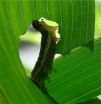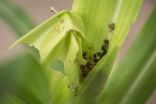INFORMATION:
The research was supported by the U.S. Department of Agriculture.
Caterpillar deceives corn plant into lowering defenses against it
2015-09-09
(Press-News.org) In a deception that likely has evolved over thousands of years, a caterpillar that feeds on corn leaves induces the plant to turn off its defenses against insect predators, allowing the caterpillar to eat more and grow faster, according to chemical ecologists in Penn State's College of Agricultural Sciences.
The finding is one more revelation about the myriad of chemical signals that pass between plants and insects that scientists at Penn State and around the world have been discovering in recent years. In this case, the agent of deceit is the caterpillar's feces, or "frass."
Plants are under constant threat of attack from herbivorous insects. Nearly 400,000 plant-eating insect species are known to live on 300,000 plant species. When these herbivores feed on plants, they not only cause mechanical damage but often deposit substances that can manipulate the plant's response to herbivory. These substances are analogous to the microbial-associated compounds that affect plant responses to pathogenic fungi or bacteria.
Fall armyworm larvae are voracious feeders on leaves in the confined whorls of corn plants, and by necessity the insects defecate nearby in the crevasses where the leaves meet the stalks. Copious amounts of frass accumulate in these structures and can remain there for a long period of time.
"It would be disadvantageous for the insect to deposit cues that could enhance plant defenses against it, so we investigated what chemical compounds in the frass were signaling the plant," said Dawn Luthe, professor of plant stress biology.
"It turns out that the caterpillar frass tricks the plant into sensing that it is being attacked by fungal pathogens and mounting a defense against them, thereby suppressing the plant's defenses against herbivores. Plants cannot defend against both pathogens and insect attackers simultaneously -- they must switch on either their pathway to defend against herbivores or their pathway to defend against pathogens."
The research, recently published in the Journal of Chemical Ecology, may lead to the isolation of specific components of the frass that can be incorporated into a compound to be sprayed on crops. Such an organic, ecologically sustainable pesticide could enhance plant defenses against pathogens, Luthe said. Or perhaps plants may be genetically modified to incorporate the proteins from the frass to boost a crop's native resistance to pathogens.
Caterpillar frass is composed of molecules derived from the host plant, the insect itself and associated microbes, and hence it provides abundant cues that may alter plant defense responses, explained lead researcher Swayamjit Ray, who is a doctoral student in the intercollege Plant Biology program at Penn State. He pointed out that proteins from fall armyworm caterpillar frass initially induced wound-responsive defense genes in corn; however, a pathogenesis-related defense gene was induced shortly after.
The elicitation of pathogen defenses by frass proteins was correlated with increased herbivore growth and reduced fungal pathogen prevalence over time, the researchers report. These responses differ from the typical plant response to oral secretions of the fall armyworm caterpillar, and the results pave the way for identification of a protein molecule from the excretion of an herbivore that elicits pathogen-defense responses while suppressing herbivore defenses in plants.
To test their hypothesis, researchers applied frass extract to the leaves of corn plants and compared the growth of fall armyworm caterpillars that fed on the leaves to the growth of caterpillars that fed on untreated leaves. They also measured the performance of a fungal pathogen in response to frass treatment of corn leaves. They inoculated the leaves with spores of a fungus that causes leaf blight in corn (Cochliobolus heterostrophus).
"The plant perceives that it is being attacked by a pathogen and not an insect, so it turns on its defenses against pathogens, leaving the caterpillar free to continue feeding on the plant. It is an ecological strategy that has been perfected over thousands of years of evolution," Ray said.
ELSE PRESS RELEASES FROM THIS DATE:
One step towards faster organic electronics
2015-09-09
Organic electronics has many advantages: it is inexpensive, flexible and lightweight. In terms of applications, we are only limited by our imaginations. There has been a lot of development in polymers since the phenomenon of conducting and semi-conducting plastics was discovered and in 2000 awarded a Nobel Prize. Their weakness is still speed; plastics conduct a charge slowly, compared to silicon, for instance.
A polymer consists of long chains of hydrocarbon, where other elements are bound, which give the particular plastic its properties. Research is underway, and researchers ...
Android widgets may boost effectiveness of sleep-monitoring apps
2015-09-09
An effective smart phone application should make data collection easy, but not so easy that the user forgets to access and reflect on that information, according to a team of researchers.
People who accessed a sleep monitoring app through a small display window -- often called a widget -- on an Android smart phone were more likely to manually enter their diary information, as well as interact with that data than users who monitored their sleep without the feature, according to Eun Kyoung Choe, assistant professor of information sciences and technology, Penn State.
"As ...
Human-like nose can sniff out contamination in drinking water
2015-09-09
Amsterdam, September 9, 2015 - A bioelectronic nose that mimics the human nose can detect traces of bacteria in water by smelling it, without the need for complex equipment and testing. According to a study published in Biosensors and Bioelectronics the technology works by using the smell receptors in the human nose.
The sensor is simple to use and it can detect tiny amounts of contamination in water, making it more sensitive than existing detection methods. The authors of the study, from Seoul National University, say this could make the technology even more useful in ...
Older kids less likely to have car seats checked for safety than infants
2015-09-09
ANN ARBOR, Mich. -- Booster seat-aged children are twice as likely to suffer serious injury or death in a car crash than younger children but a new study shows they may be less likely to have car seats inspected for proper use.
Less than a quarter of car seat and booster checks analyzed in the new University of Michigan Health System study were conducted in children ages four and older at car seat inspection stations in Michigan. Just 1 in 10, or 11 percent of inspections, covered booster seat-age children ages 4-7 while half were for rear-facing car seats.
The findings, ...
How hashtags and @ symbols affect language on Twitter
2015-09-09
Despite all the shortened words and slang seen on Twitter, it turns out that people follow many of the same communication etiquette rules on social media as they do in speech. Research from the Georgia Institute of Technology shows that when tweeters use hashtags -- a practice that can enable messages to reach more people -- they tend to be more formal and drop the use of abbreviations and emoticons. But when they use the @ symbol to address smaller audiences, they're more likely to use non-standard words such as "nah," "cuz" and "smh." The study also found when people ...
How can one assess the effectiveness of hypnosis?
2015-09-09
This news release is available in French. Although hypnosis has existed for hundreds of years, today it is still difficult to clearly judge its usefulness in the medical domain. In a report submitted to the French Directorate General for Health, researchers from Inserm led by Bruno Falissard assessed the effectiveness of this complementary medical practice for some of its indications (women's health, digestive ailments, surgery, psychiatry, etc.). The latter illustrates its therapeutic value during anaesthesia, and in the management of irritable bowel syndrome. It also ...
The sweet smell of success
2015-09-09
Catch a whiff of an enchanting perfume, the sweet smell of freshly cut grass, newly baked bread, even the odor of two-stroke engine fumes, and many of us are whisked off to distant places in our memories. Smells trigger immediate emotional responses and marketing departments the world over have exploited this everywhere from supermarkets to car showrooms to help us part with our hard-earned cash.
Now, writing in the International Journal of Trade and Global Markets, Shuvam Chatterjee of the Regent Education & Research Foundation, in Dhakuria, India, discusses the concept ...
Mindfulness may make memories less accurate
2015-09-09
Mindfulness meditation is associated with all sorts of benefits to mental and physical well-being, but a new study suggests that it may also come with a particular downside for memory. The findings, published in Psychological Science, a journal of the Association for Psychological Science, show that participants who engaged in a 15-minute mindfulness meditation session were less able to differentiate items they actually encountered from items they only imagined.
"Our results highlight an unintended consequence of mindfulness meditation: memories may be less accurate," ...
Making pharmaceuticals that degrade before they can contaminate drinking water
2015-09-09
In recent years, researchers have realized that many products, including pharmaceuticals, have ended up where they're not supposed to be -- in our drinking water. But now scientists have developed a way to make drugs that break down into harmless compounds before they contaminate our taps. Their report appears in ACS' journal Environmental Science & Technology.
A wide range of active ingredients originating from pesticides, shampoos, lotions, cosmetics, disinfectants and drugs get washed into sewage systems or rivers and streams, ending up in our tap water. Scientists ...
New Ebola test could help curb disease spread
2015-09-09
Amsterdam, September 9, 2015 - A new Ebola test that uses magnetic nanoparticles could help curb the spread of the disease in western Africa. Research published in Biosensors and Bioelectronics shows that the new test is 100 times more sensitive than the current test, and easier to use. Because of this, the new test makes it easier and cheaper to diagnose cases, enabling healthcare workers to isolate patients and prevent the spread of Ebola.
The authors of the study, from the Chinese Academy of Sciences, say their new technology could be applied to the detection of any ...


